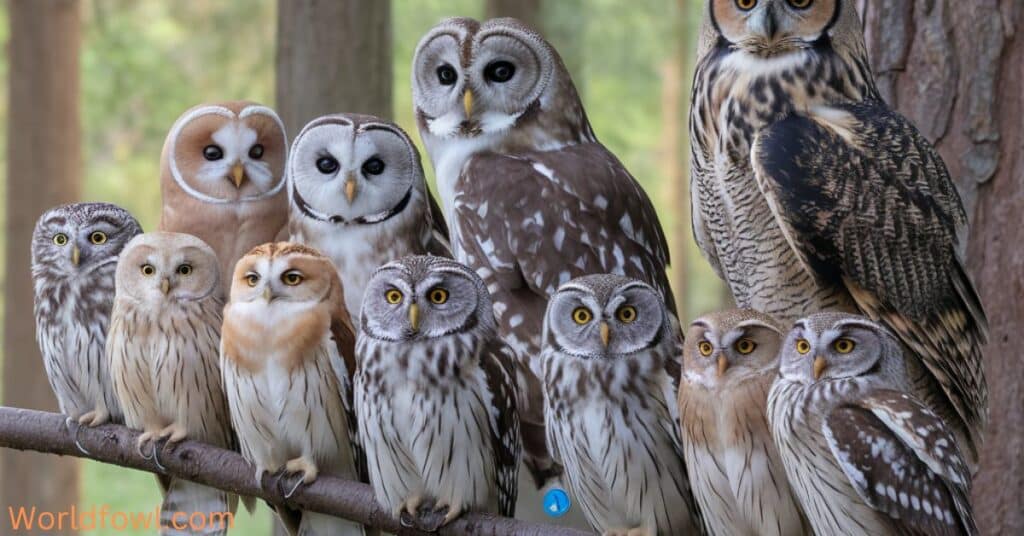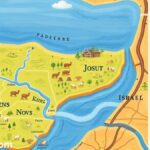Ontario’s diverse landscapes harbor a captivating array of owl species, each with its own unique characteristics and behaviors. From the diminutive Northern Saw-whet Owl to the imposing Great Grey Owl, these nocturnal hunters play crucial roles in our ecosystems. This comprehensive guide will take you on a journey through the enchanting world of Ontario owls, exploring their habitats, behaviors, and conservation status.
Table of Contents
- Understanding Owl Behavior and Identification
- 11 Owl Species in Ontario
- Conservation and Threats
- Owl-watching Ethics and Best Practices
- Conclusion
- Additional Resources
Understanding Owl Behavior and Identification
Before we dive into the specific Ontario owl species, let’s explore some key aspects of owl behavior and identification that will enhance your owl-watching experience.
Key Features for Identifying Owls
Identifying owls can be challenging, especially in low-light conditions. Here are some crucial features to look for:
- Eyes: Owl eyes are large and forward-facing, giving them excellent depth perception.
- Facial discs: These feathered circles around the eyes help funnel sound to the ears.
- Ear tufts: Some species have prominent “horns” or tufts on their heads.
- Size and shape: Pay attention to overall body size and proportions.
- Plumage patterns: Look for distinctive markings, streaks, or barring.
Best Times and Places for Owl-Spotting
To maximize your chances of seeing owls in Ontario, consider these tips:
- Time: Many owls are most active at dusk and dawn.
- Season: Winter is often the best time for owl-watching, as deciduous trees have lost their leaves.
- Habitat: Different species prefer various habitats, from dense forests to open fields.
- Weather: Owls are more likely to be active on clear, calm nights.
Owl Calls and Vocalizations
Owls communicate through a variety of calls, each species with its unique voice. Learning these calls can greatly improve your owl-finding skills. Here’s a quick guide to some common Ontario owl vocalizations:
| Species | Call Description |
| Barred Owl | “Who cooks for you? Who cooks for you-all?” |
| Great Horned Owl | Deep, resonant “hoo-h’HOO-hoo-hoo” |
| Eastern Screech-Owl | Descending trill or whinny |
| Northern Saw-whet Owl | Repetitive “toot-toot-toot” |
11 Owl Species in Ontario
Now, let’s explore the fascinating world of Ontario owl species in detail.
Barn Owl (Tyto alba)
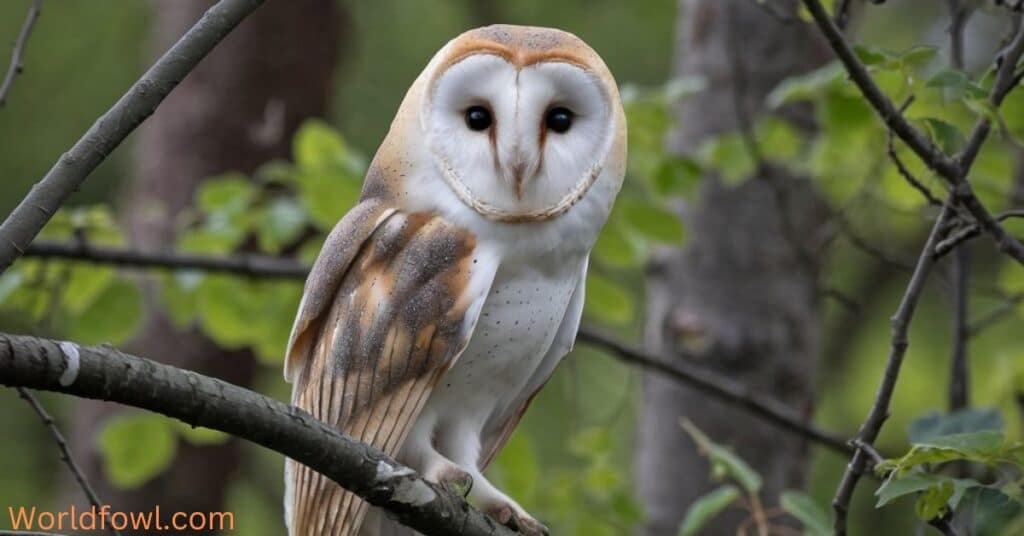
The Barn Owl, with its distinctive heart-shaped face, is a rare sight in Ontario. These ghostly predators are primarily found in southern parts of the province.
Key Facts:
- Length: 33-39 cm
- Wingspan: 107-110 cm
- Weight: 430-620 g
Habitat: Barn Owls prefer open country, including farmlands, grasslands, and marshes.
Conservation Status: The Barn Owl is listed as endangered in Ontario due to habitat loss and the conversion of old barns to modern structures.
“The Barn Owl’s silent flight and eerie screech have earned it the nickname ‘ghost owl’ in many cultures.” – Ontario Nature
Barred Owl (Strix varia)
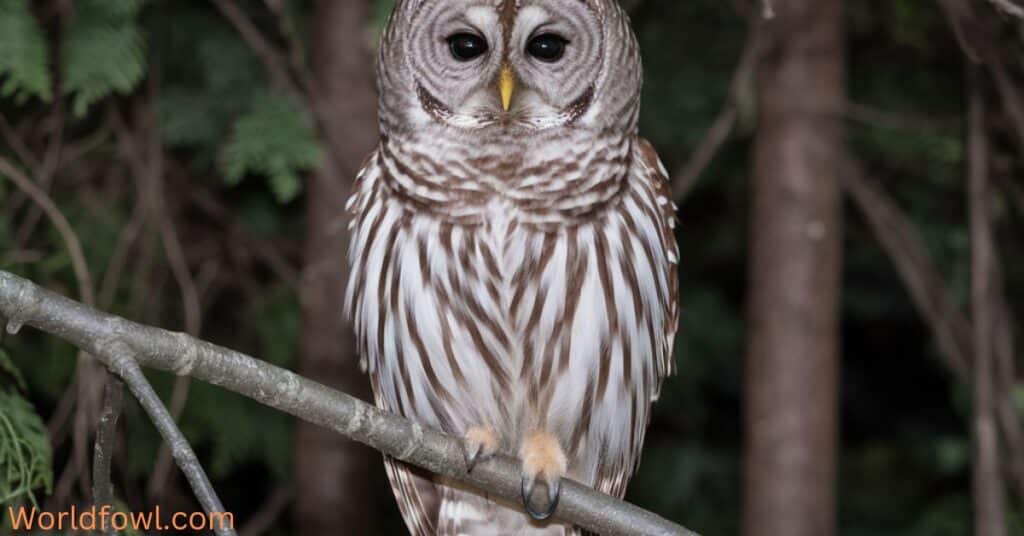
The Barred Owl is a common year-round resident in Ontario’s forests. Its distinctive “who cooks for you?” call is a familiar sound in wooded areas.
Key Facts:
- Length: 43-50 cm
- Wingspan: 99-110 cm
- Weight: 470-1,050 g
Habitat: Barred Owls inhabit mature mixed and deciduous forests, often near water bodies.
Interesting Behavior: These owls are known for their complex vocalizations, which include hoots, laughs, and even screams during mating season.
you may also like : Where Do Hummingbirds Go At Night? Hummingbird Night Life Exposed
Boreal Owl (Aegolius funereus)
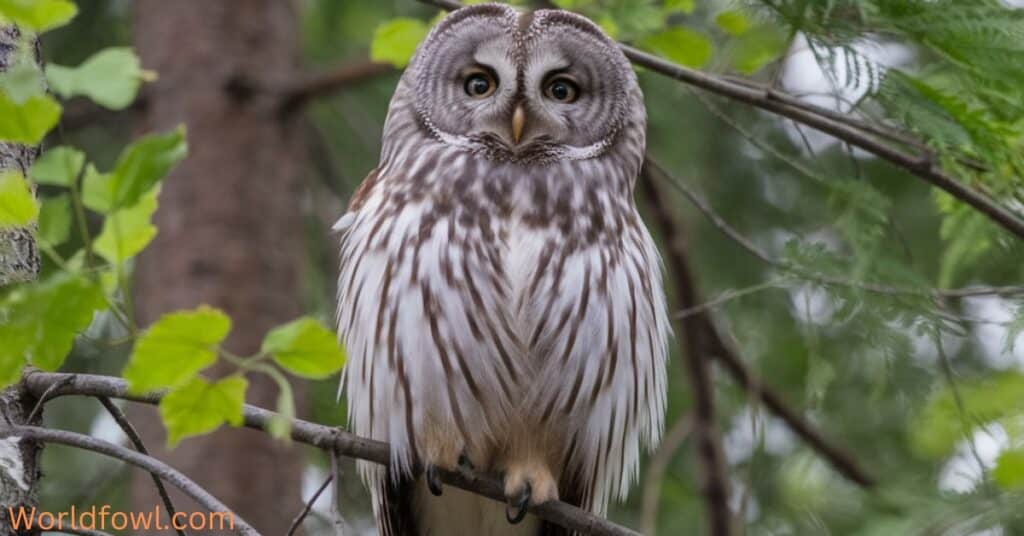
The Boreal Owl is a small, elusive species found primarily in northern Ontario’s coniferous forests.
Key Facts:
- Length: 21-28 cm
- Wingspan: 50-62 cm
- Weight: 93-194 g
Habitat: As their name suggests, Boreal Owls are specialists of the boreal forest ecosystem.
Adaptations: These owls have asymmetrical ear openings, allowing for precise sound localization when hunting in dense forests.
Eastern Screech-Owl (Megascops asio)
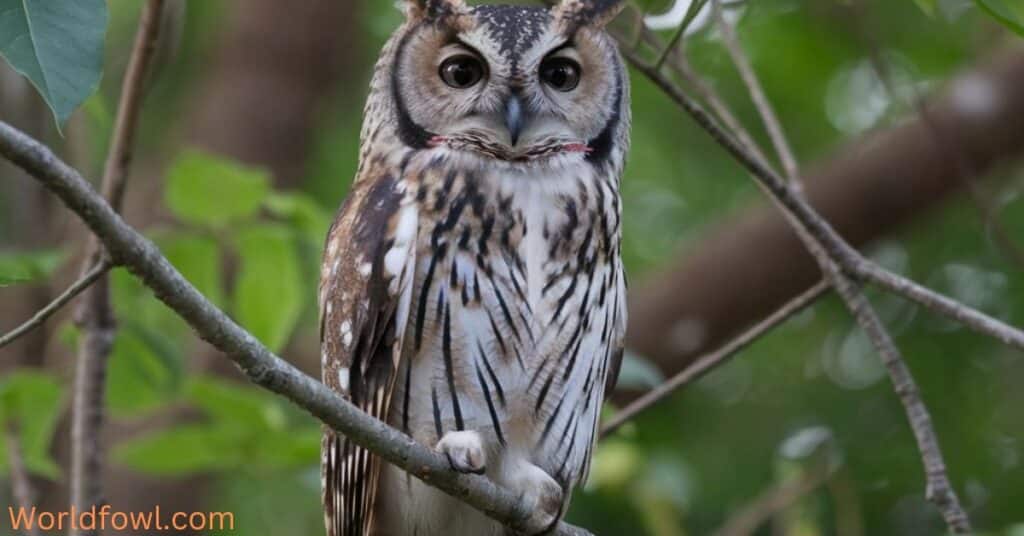
The Eastern Screech-Owl is a small, adaptable owl found throughout southern and central Ontario.
Key Facts:
- Length: 16-25 cm
- Wingspan: 46-61 cm
- Weight: 121-244 g
Habitat: These versatile owls can be found in a variety of wooded habitats, including urban parks and suburban areas.
Color Morphs: Eastern Screech-Owls come in two distinct color phases: red and gray. The ratio of these morphs varies geographically.
Great Grey Owl (Strix nebulosa)
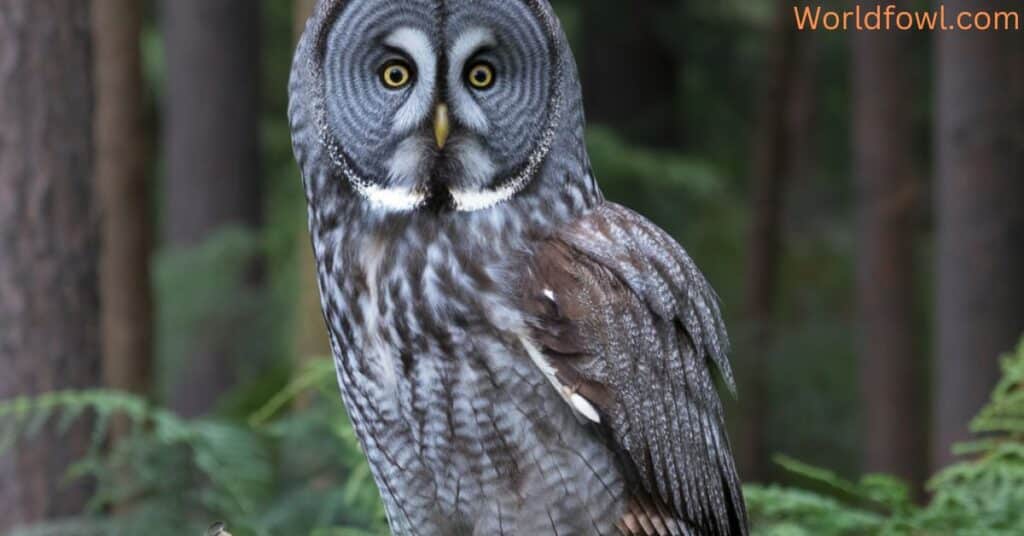
The Great Grey Owl is Ontario’s largest owl species and a true northern specialist.
Key Facts:
- Length: 61-84 cm
- Wingspan: 137-152 cm
- Weight: 790-1,454 g
Habitat: These impressive owls inhabit dense boreal forests and hunt in adjacent meadows and clearings.
Hunting Strategies: Great Grey Owls can locate prey beneath up to 30 cm of snow using their exceptional hearing.
you may also like : Can Seagulls Breathe Underwater? How Do Seagulls Avoid Drowning?
Great Horned Owl (Bubo virginianus)
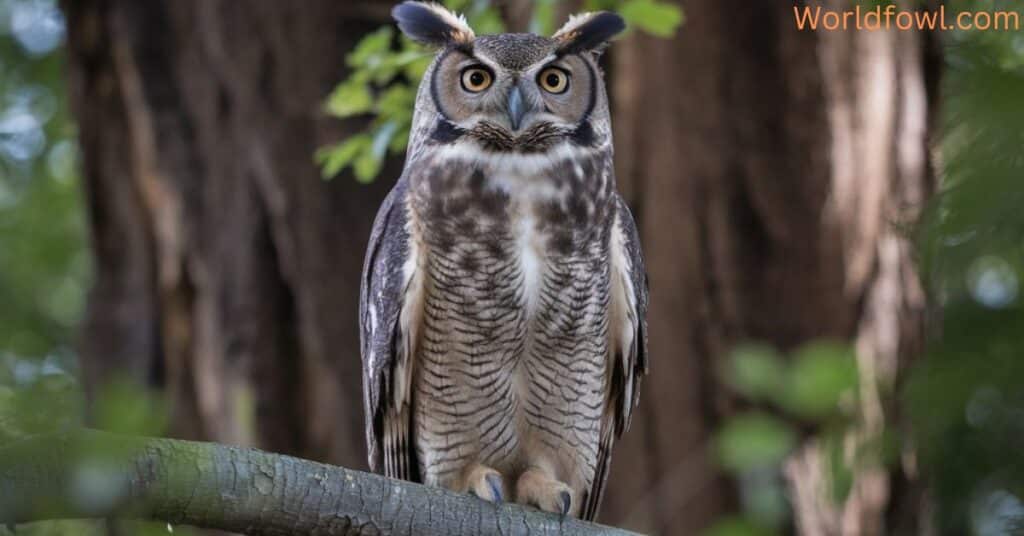
The Great Horned Owl is a powerful predator found year-round throughout Ontario.
Key Facts:
- Length: 46-63 cm
- Wingspan: 101-145 cm
- Weight: 910-2,500 g
Habitat: These adaptable owls can be found in a wide range of habitats, from dense forests to urban areas.
Diet: Great Horned Owls have the most diverse prey base of any North American owl, including mammals, birds, reptiles, and even other owls.
Long-eared Owl (Asio otus)
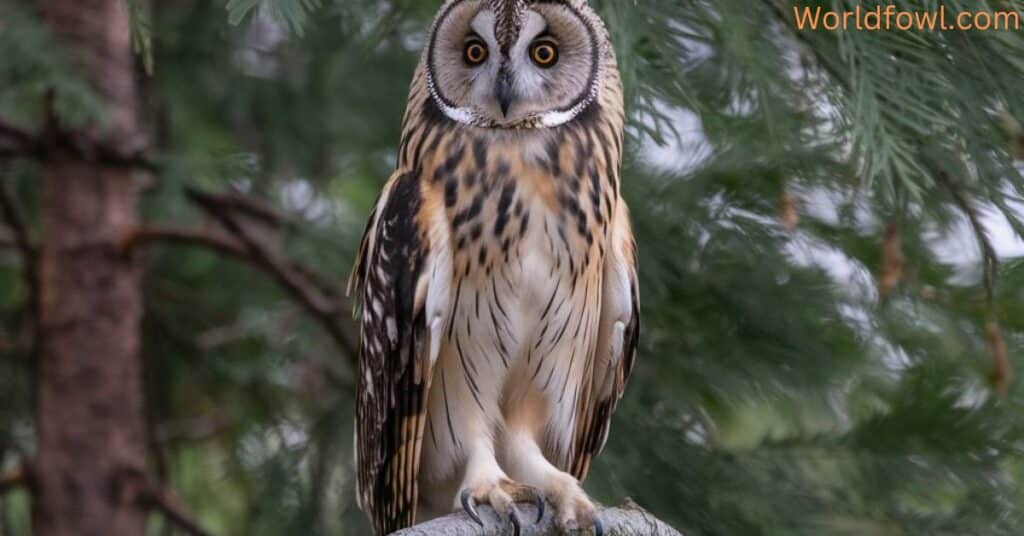
The Long-eared Owl is a medium-sized owl known for its camouflage abilities and distinctive ear tufts.
Key Facts:
- Length: 35-40 cm
- Wingspan: 90-100 cm
- Weight: 220-435 g
Habitat: These owls prefer dense coniferous or mixed forests adjacent to open areas for hunting.
Communal Roosting: During winter, Long-eared Owls often form communal roosts of up to 100 individuals.
Northern Hawk Owl (Surnia ulula)
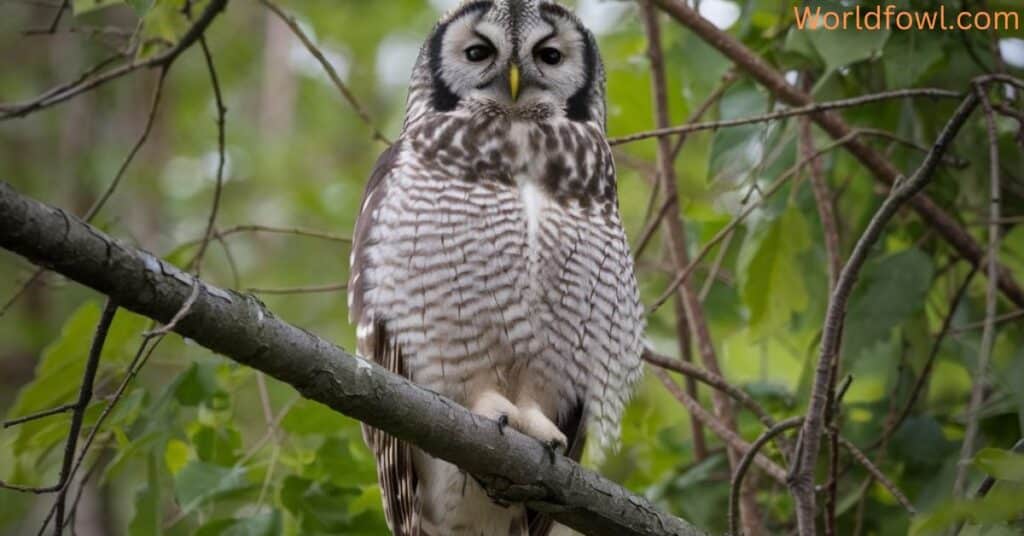
The Northern Hawk Owl is a unique species that combines owl and hawk-like characteristics.
Key Facts:
- Length: 36-43 cm
- Wingspan: 45 cm
- Weight: 300 g
Habitat: These owls inhabit boreal forests and are often seen perched atop tall trees or snags.
Diurnal Behavior: Unlike most owls, Northern Hawk Owls are active during daylight hours, especially in the long summer days of their northern range.
Northern Saw-whet Owl (Aegolius acadicus)
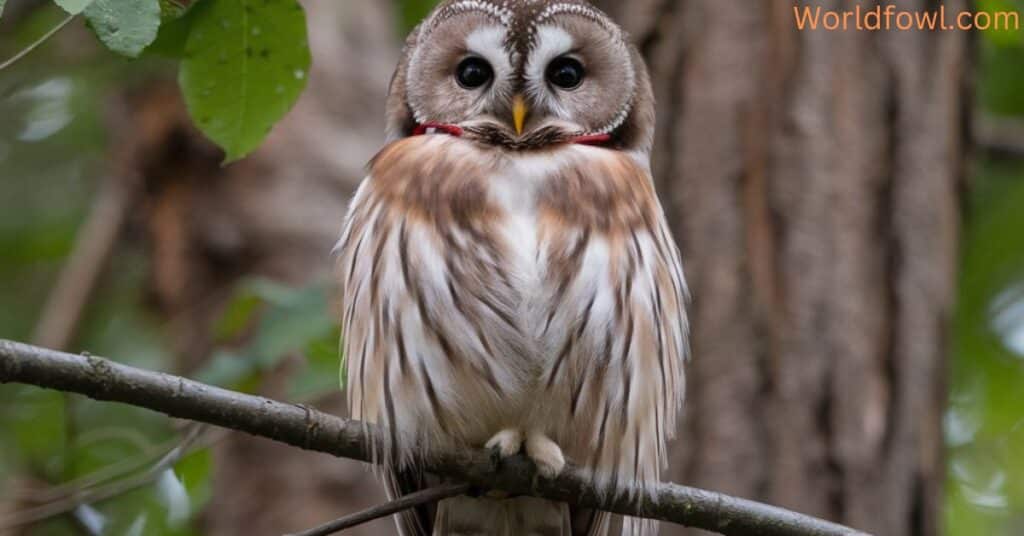
The Northern Saw-whet Owl is Ontario’s smallest owl species and a favorite among birdwatchers.
Key Facts:
- Length: 17-22 cm
- Wingspan: 42-56 cm
- Weight: 65-151 g
Habitat: These tiny owls prefer dense coniferous or mixed forests, often near water.
Migration: Northern Saw-whet Owls undergo a notable fall migration, with large numbers passing through southern Ontario.
Short-eared Owl (Asio flammeus)
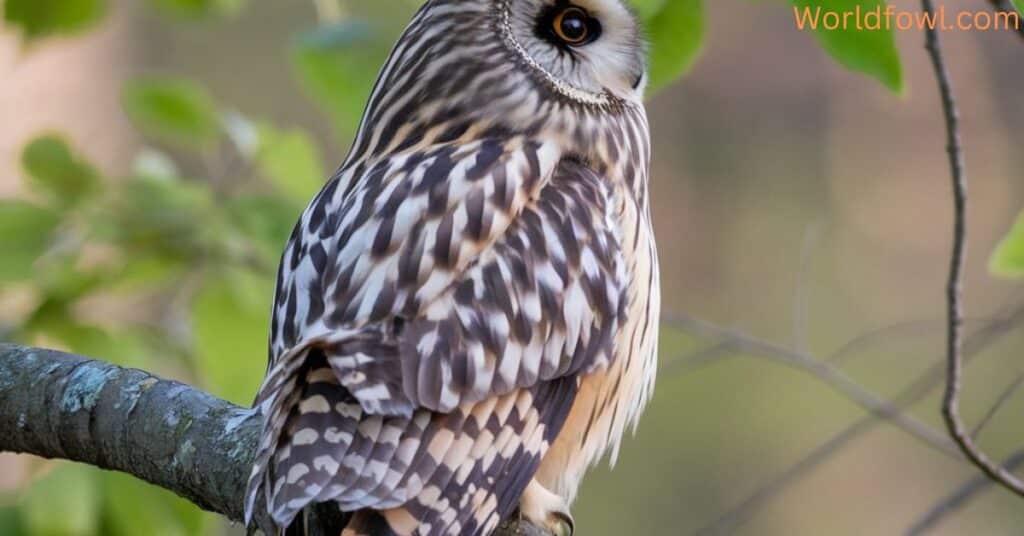
The Short-eared Owl is an open country specialist found in grasslands and marshes across Ontario.
Key Facts:
- Length: 34-43 cm
- Wingspan: 85-110 cm
- Weight: 206-475 g
Habitat: These owls prefer open habitats like grasslands, tundra, and coastal marshes.
Ground-nesting: Unlike most owls, Short-eared Owls nest on the ground, making them vulnerable to disturbance and predation.
you also like : Do Robins Mate For Life? The Complete Guide To Robin Romance
Snowy Owl (Bubo scandiacus)
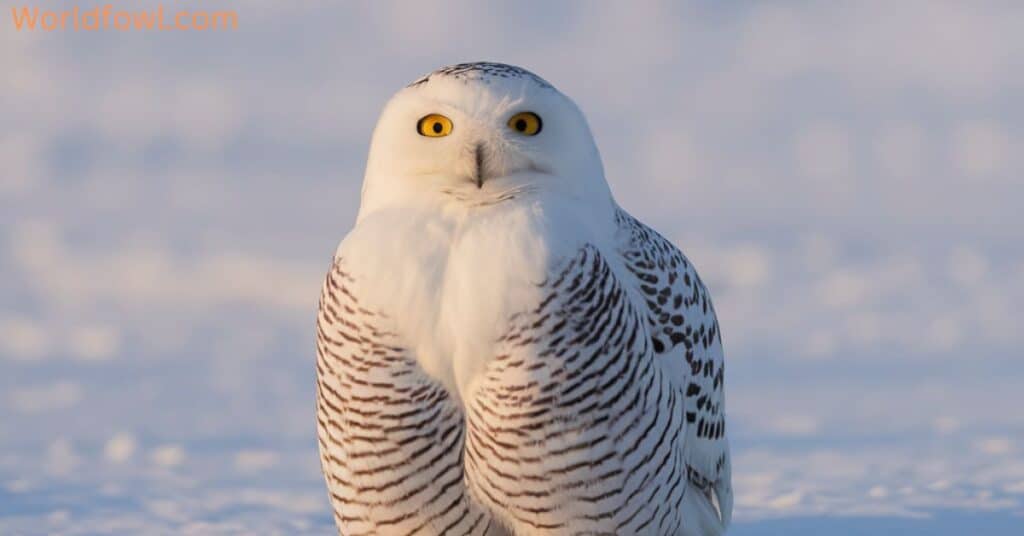
The majestic Snowy Owl is an Arctic visitor that sometimes ventures into southern Ontario during winter.
Key Facts:
- Length: 52-71 cm
- Wingspan: 125-150 cm
- Weight: 1,600-2,950 g
Habitat: In Ontario, Snowy Owls are often found in open areas that resemble their Arctic tundra home, such as airports, fields, and coastal areas.
Irruptive Movements: Some winters see large influxes of Snowy Owls into southern Ontario, likely due to fluctuations in lemming populations in their Arctic breeding grounds.
Conservation and Threats
Ontario’s owl populations face various challenges that threaten their long-term survival. Understanding these issues is crucial for effective conservation efforts.
Habitat Loss and Fragmentation
The loss and fragmentation of suitable owl habitat is perhaps the most significant threat to Ontario owl species. Factors contributing to this issue include:
- Urban expansion
- Agricultural intensification
- Logging of old-growth forests
- Drainage of wetlands
Case Study: Barn Owl Decline The Barn Owl’s endangered status in Ontario is largely due to habitat loss. The conversion of old barns and silos to modern structures has dramatically reduced suitable nesting sites. Additionally, the loss of grasslands and meadows has diminished their hunting grounds.
Climate Change Impacts
Climate change poses a significant threat to Ontario’s owls, particularly boreal specialists like the Boreal Owl and Great Grey Owl. Potential impacts include:
- Shifts in prey availability
- Changes in forest composition
- Altered migration patterns
- Increased competition from southern species expanding northward
Human-Owl Conflicts
As human development encroaches on owl habitats, conflicts can arise:
- Vehicle collisions
- Poisoning from rodenticides
- Disturbance of nesting sites
- Entanglement in barbed wire fences
Owl-watching Ethics and Best Practices
Responsible owl-watching is crucial for the conservation of these magnificent birds. Here are some guidelines to follow:
- Respect owl habitats: Keep a safe distance from nesting sites and roosts.
- Use appropriate equipment: Binoculars and spotting scopes allow for observation without disturbance.
- Limit artificial light: Avoid using flashlights or camera flashes, which can disorient owls.
- Control noise levels: Speak quietly and turn off cell phones to minimize disturbance.
- Stay on designated trails: This helps protect sensitive habitats and reduces stress on wildlife.
- Educate others: Share your knowledge and promote responsible owl-watching practices.
“The key to successful owl-watching is patience, respect for the birds, and a willingness to adapt to their nocturnal lifestyle.” – Ontario Field Ornithologists
Conclusion
Ontario’s diverse owl population offers endless opportunities for discovery and appreciation. From the tiny Northern Saw-whet Owl to the imposing Great Grey Owl, each species plays a vital role in our ecosystems. By understanding their behaviors, habitats, and conservation needs, we can better protect these magnificent birds for future generations to enjoy.
As you explore the world of Ontario owls, remember that every observation, no matter how small, contributes to our collective knowledge. Consider participating in citizen science projects or joining local birding groups to share your sightings and learn from others.
The next time you hear a mysterious hoot in the night or catch a glimpse of silent wings against the moon, take a moment to appreciate the incredible adaptations and behaviors that make owls such successful and captivating predators. With continued efforts in conservation and responsible wildlife watching, we can ensure that the enchanting world of Ontario’s owls remains a source of wonder and inspiration for years to come.
Additional Resources
For those eager to delve deeper into the world of Ontario owl species, here are some valuable resources:
Recommended Field Guides and Apps
- “Owls of North America” by Wayne Lynch
- “Peterson Field Guide to Birds of Eastern and Central North America”
- Merlin Bird ID App (free, by Cornell Lab of Ornithology)
Seasonal Owl Behavior in Ontario
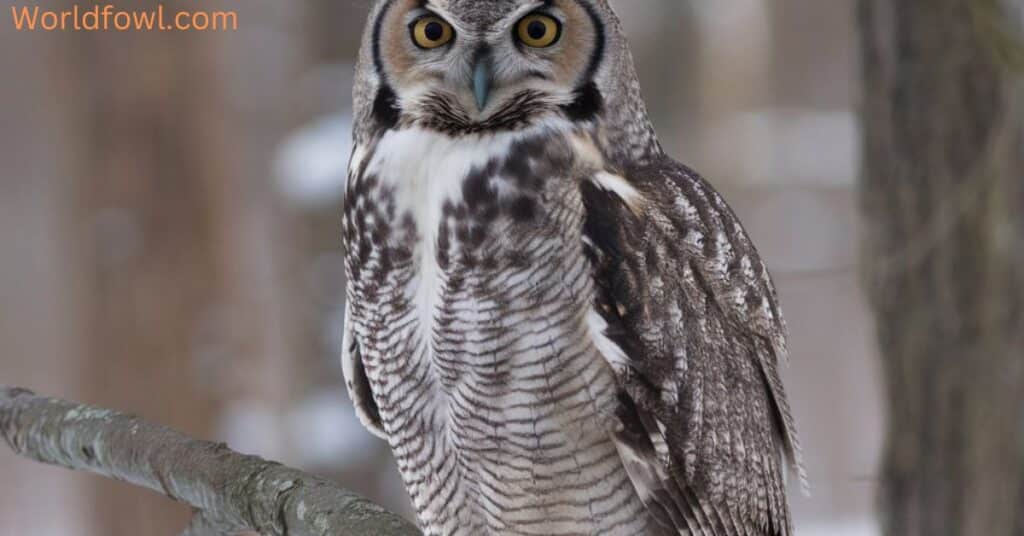
Understanding the seasonal patterns of Ontario owls can greatly enhance your owl-watching experience. Let’s explore how these magnificent birds adapt to the changing seasons.
Spring: Nesting Season
Spring is a crucial time for owls in Ontario. Here’s what you might observe:
- Increased Vocalizations: Many owl species become more vocal as they establish territories and attract mates.
- Nesting Activities: Owls begin selecting nest sites, with some species like the Great Horned Owl starting as early as February.
- Courtship Displays: Watch for elaborate courtship rituals, especially among Barred Owls and Great Grey Owls.
“Spring nights in Ontario’s forests come alive with the courtship calls of owls, a testament to the renewal of life after long winters.” – Ontario Nature
Summer: Raising Young
Summer is a busy time for owl parents:
- Fledging: Young owls begin to leave the nest, often before they can fly properly.
- Hunting Lessons: Parent owls teach their young essential hunting skills.
- Territorial Behavior: Adult owls fiercely defend their nesting areas from intruders.
Fall: Migration and Dispersal
Fall brings significant changes to Ontario’s owl populations:
- Migration: Some species, like the Short-eared Owl, may move south for the winter.
- Irruptions: Certain years may see influxes of northern species like Snowy Owls into southern Ontario.
- Juvenile Dispersal: Young owls of resident species disperse to establish their own territories.
Winter: Survival Strategies
Winter presents unique challenges and opportunities for owls:
- Increased Visibility: Leafless trees make spotting owls easier for birdwatchers.
- Altered Hunting Patterns: Some owls, like the Great Grey Owl, may become more diurnal to take advantage of limited daylight.
- Communal Roosting: Species such as Long-eared Owls may form winter roosts for warmth and protection.
Owl Adaptations: Masters of the Night
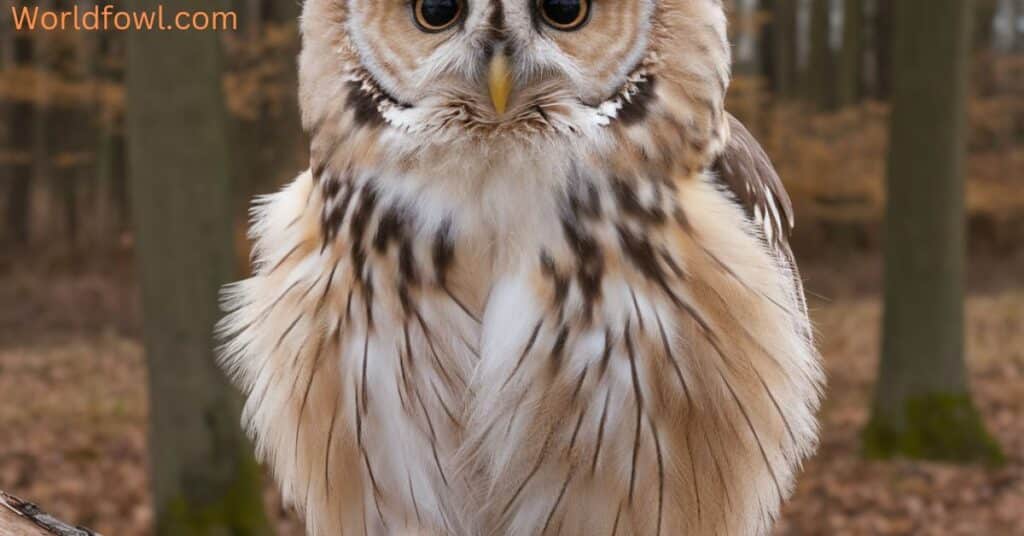
Ontario’s owls possess remarkable adaptations that make them supremely suited for their nocturnal lifestyle. Let’s explore some of these fascinating features:
Silent Flight
Owls are renowned for their ability to fly silently, a crucial adaptation for sneaking up on prey. This silent flight is achieved through several unique features:
- Serrated Feather Edges: The leading edge of an owl’s flight feathers has a comb-like fringe that breaks up the airflow, reducing noise.
- Velvet-like Surface: The upper surface of an owl’s wings is covered in a velvety down that further muffles sound.
- Fringed Trailing Edges: The back edge of the wing feathers is soft and flexible, allowing air to pass through silently.
Exceptional Hearing
Owls have some of the most sophisticated hearing in the animal kingdom:
- Asymmetrical Ear Openings: Many owl species, including the Boreal Owl, have ear openings at different heights on their skull, allowing for precise sound localization.
- Facial Disc: The distinctive disc of feathers around an owl’s face acts like a satellite dish, funneling sound to the ears.
- Movable Ear Flaps: Some species can adjust the shape of their ear openings to better focus on sounds.
Specialized Vision
Well-adapted for low-light conditions:
- Large Eyes: An owl’s eyes can occupy up to 5% of its body weight, compared to 0.003% in humans.
- Rod-Dominated Retinas: Owls have a high concentration of rod cells, which are sensitive to light but not color, enhancing their night vision.
- Binocular Vision: Forward-facing eyes provide excellent depth perception, crucial for judging distances when hunting.
you may like : Crane Vs. Heron – The Complete Comparison
Owl Pellets: Windows into Owl Diets
Owl pellets are a fascinating byproduct of an owl’s digestive process and can provide valuable insights into their diets and local ecosystems.
What Are Owl Pellets?
Owl pellets are regurgitated masses containing the indigestible parts of an owl’s prey, such as bones, fur, and feathers. They are typically oval-shaped and can vary in size depending on the owl species.
Analyzing Owl Pellets
Researchers and curious naturalists often dissect owl pellets to learn about:
- Prey Species: Identifying bones in pellets can reveal which animals the owl has been eating.
- Local Biodiversity: Pellets can provide information about small mammal populations in an area.
- Environmental Changes: Long-term pellet studies can show shifts in prey availability over time.
“Owl pellets are like time capsules, offering a glimpse into the hidden lives of these nocturnal hunters and the ecosystems they inhabit.” – Ontario Field Ornithologists
Owl Conservation Success Stories in Ontario
Despite the challenges facing owl populations, there have been some notable conservation successes in Ontario:
Barn Owl Recovery Program
While still endangered, Barn Owl populations in Ontario have seen some improvement thanks to dedicated conservation efforts:
- Nest Box Programs: Installation of specially designed nest boxes in suitable habitats has provided nesting sites.
- Habitat Restoration: Efforts to restore and protect grassland habitats have improved hunting grounds for Barn Owls.
- Public Education: Increased awareness has led to more landowner cooperation in Barn Owl conservation.
Eastern Screech-Owl Urban Adaptation
The Eastern Screech-Owl has shown remarkable adaptability to urban environments:
- Urban Nest Boxes: Many city dwellers have successfully attracted Eastern Screech-Owls to their yards with nest boxes.
- Green Space Preservation: Urban planning that incorporates green corridors has helped maintain owl populations in cities.
Boreal Forest Conservation
Efforts to protect large tracts of boreal forest have benefited northern owl species like the Great Grey Owl and Boreal Owl:
- Protected Areas: Expansion of protected areas in northern Ontario has preserved critical owl habitat.
- Sustainable Forestry Practices: Implementation of owl-friendly forestry practices has helped maintain habitat in working forests.
Citizen Science: How You Can Contribute to Owl Research
Citizen science projects offer excellent opportunities for owl enthusiasts to contribute to scientific knowledge and conservation efforts:
- Ontario Nocturnal Owl Survey: This annual survey helps track owl populations across the province.
- Project SNOWstorm: This project focuses on tracking and studying Snowy Owls during their winter visits to southern Ontario.
- eBird: This global database of bird observations includes valuable data on owl sightings and behaviors.
Tips for Participating in Owl Citizen Science:
- Learn Owl Calls: Familiarize yourself with the vocalizations of Ontario’s owl species.
- Keep Detailed Records: Note the date, time, location, and behavior of any owls you observe.
- Follow Protocols: Adhere to the specific guidelines of each citizen science project.
- Respect Owl Welfare: Always prioritize the well-being of the owls over getting a perfect photo or observation.
By participating in these projects, you not only contribute to scientific knowledge but also deepen your own understanding and appreciation of Ontario owls.
Conclusion
The world of Ontario owls is rich with wonder and complexity. From the silent wings of the Barn Owl to the piercing yellow eyes of the Great Horned Owl, these birds captivate our imagination and play crucial roles in our ecosystems. As we continue to learn about their behaviors, adaptations, and conservation needs, we become better stewards of the natural world.
Whether you’re a seasoned birder or a curious newcomer, the owls of Ontario offer endless opportunities for discovery and appreciation. By observing responsibly, supporting conservation efforts, and sharing your knowledge with others, you can help ensure that future generations will also have the chance to experience the magic of hearing a Barred Owl‘s call echoing through a misty forest or glimpsing a Snowy Owl perched majestically on a winter field.
Remember, every owl sighting, every moment spent in quiet observation, and every effort to protect their habitats contributes to the broader tapestry of owl conservation in Ontario. So grab your binoculars, head out into the twilight, and let the mysterious world of owls inspire your connection to the natural wonders of Ontario.

Henry James is a seasoned blogger and a passionate storyteller on “World Fowl.” With years of experience crafting engaging content, he brings a unique blend of expertise and creativity to his writing. Henry specializes in exploring diverse topics with depth and clarity, captivating readers worldwide.

